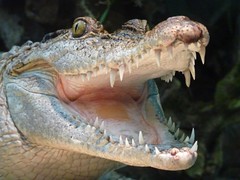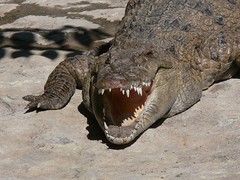The Philippine crocodile (Crocodylus mindorensis), "buwaya" in local term is another endemic freshwater crocodile in the Philippines which is considered in IUCN as critically endangered species. Crocodylus mindorensis derived its name from Mindoro Island. Recently it is found that Philippine crocodile is a subspecies of the New Guinea Crocodile (Crocodylus novaeguinae). Before, this kind of crocodile is found throughout the Philippines but due to exploitation and destruction of habitat an estimated of less than 100 non-hatchling are surviving in the wild. Today there are still surviving population in the Northern Sierra Madre National Park, San Mariano, Isabela, Dalupiri Island, Babuyan Islands, Abra Province and Ligawasan Marsh in Mindanao.
The Philippine Crocodile lives in freshwater like marshes, ponds, lakes, and rivers. They relatively small species of crocodile which grows not more than 3 meters and the female is relatively smaller. They have broad snout and thick bony plates (dorsal armor) on their back and they have golden-brown in color which darkens as it matures. The number of teeth range from 66 to 68. They feed on aquatic invertebrates and small vertebrates. During breeding they build a small nest 50cm tall and 150cm wide, female lay 7-20 eggs which will be hatch approximately after 85 days.
In 2007, the Crocodile Conservation Society Philippines was founded by a specialist group involved in conservation of crocodiles. This group is working for captive breeding and release programs in conjunction with the Zoological Institute of Herpaworld in Mindoro, the Palawan Rescue and Conservation Centre, Siliman University and the Dutch/Filipino Mabuwaya foundation.
In 2009, 50 captive bred Philippine crocodiles were released in the wild in Dicatian Lake, Divilacan, Isabela Province. They are bred in PWRCC (Palawan Wildlife Rescue and Conservation Center) of the DENR. The Mabuwaya Foundation in Isabela implemented the conservation program with funding from UK-registered Rufford Maurice Laing Foundation. Ten of the crocodiles released in the wild with radio transmitters basis of study.
 Image via Wikipedia Image via Wikipedia |
| Small Philippine Crocodile |
 Image via Wikipedia Image via Wikipedia |
| Juvenile Philippine Crocodile |
 Image via Wikipedia Image via Wikipedia |
| Closer look of Crocodylus Mindorensis |
 Image by Sibylle Stofer via Flickr Image by Sibylle Stofer via Flickr |
| Matured Philippine Crocodile with open mouth |
 Image by daktre via Flickr Image by daktre via Flickr |
| Full grown Philippine Crocodile |
 |
| Philippine Crocodile in swamp |
 |
| Philippine Crocodile lying on ground |
 |
| Dorsal profile on the back of Philippine crocodile |
 |
| Young Philippine crocodile |

 Image via Wikipedia
Image via Wikipedia Image via Wikipedia
Image via Wikipedia Image via Wikipedia
Image via Wikipedia Image by Sibylle Stofer via Flickr
Image by Sibylle Stofer via Flickr Image by daktre via Flickr
Image by daktre via Flickr




No comments:
Post a Comment